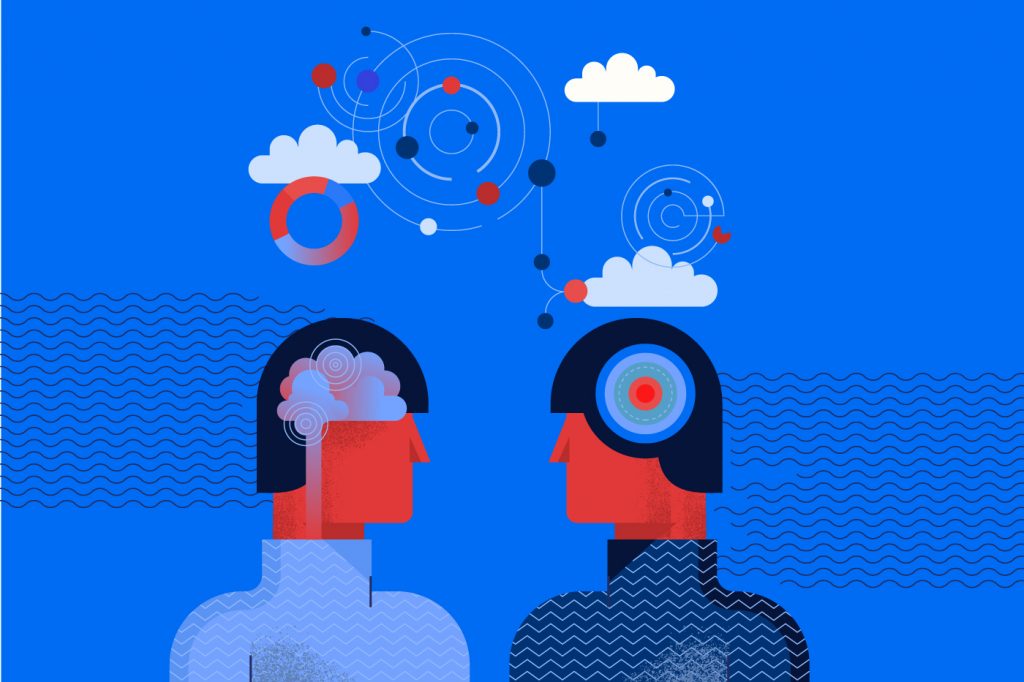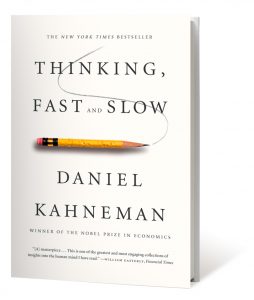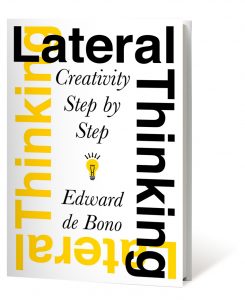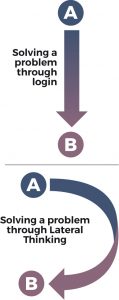Novel Ways of Thinking in Finance
Critical and Lateral Thinking, the winning combination.

By Derek Ariss
Let’s face it. Where would we be if we didn’t have problems to solve? Throughout time, the ability of people to think has been crucial. We use thinking to communicate and create new opportunities, to develop strategies, devise tactics, and….yes, to solve problems. As we know, in banking, we solve a lot of problems.
In this article, I introduce you to two types of Deliberate Thinking: Critical and Lateral Thinking. Both thought processes have strengths and combined, they create an essential toolkit in business.
Critical Thinking is to apply reasoning to evaluate information and identify the best answer. It’s about separating truth from falsehood, assessing strengths and weaknesses in order to find one best conclusion.
Lateral Thinking is about identifying opportunities from various sources and then using appropriate methods to create unique and original solutions.
Let’s first take a closer view at Critical Thinking.
Critical Thinking is about the analysis of facts to form a judgment, to get to the one decision point.
We constantly apply this analytical process in business. We look at data, information, context, evaluate it, and then select the best decision to act upon. In banking, we use deductive and inductive reasoning methods. To do this well, it is essential that the evaluation is factual and unbiased. How do our minds go about processing information to think critically? Let’s look at how we think and at some shortcomings to be aware of in Critical Thinking.
 Daniel Kahneman is a senior scholar at Princeton University and a Professor of Public Affairs at Woodrow Wilson School of Public and International Affairs. He was awarded the Nobel Prize in Economics in 2002 and wrote a landmark book titled Thinking, Fast and Slow. This book is an excellent reference to understand how we think and some pitfalls that occur when we do Critical Thinking.
Daniel Kahneman is a senior scholar at Princeton University and a Professor of Public Affairs at Woodrow Wilson School of Public and International Affairs. He was awarded the Nobel Prize in Economics in 2002 and wrote a landmark book titled Thinking, Fast and Slow. This book is an excellent reference to understand how we think and some pitfalls that occur when we do Critical Thinking.
In Thinking, Fast and Slow, Kahneman discusses two types of thinking modes of our brains. These modes he calls System 1 and System 2 Thinking.
System 1 Thinking is fast and emotionally driven thinking. It’s the intuition side of our thoughts. System 1 is often automatic and impulsive. This is where our ‘gut feeling’ comes from.
System 1 Thinking is used to help us perceive the world around us, recognise objects, and identify threats quickly. It’s also critical for our survival, e.g. when you cross the street, and you jump out of the way of an oncoming bicycle. This is System 1 Thinking at work. Without System 1 Thinking, you may have been hit by that bicycle!
System 2 Thinking is different. It is slower, more analytical, and deeper thinking. System 2 Thinking is about being conscious, aware, and reasonable. Thoughts here are deliberate, have depth, and are well placed. It is this thinking that takes a little bit of time. System 2 Thinking allows us to filter through information to get to the correct answer. Imagine it is like a coffee percolator. The thoughts filter through our brain more slowly and take time to process. Often when we are not familiar with something or the information does not come naturally, we use System 2 Thinking to develop the solution. It seems logical that this is the process that we should be using when utilising Critical Thinking. A note of caution. Even when we should be using System 2 Thinking, we tend to prefer System 1 Thinking. For some reason, we tend to have subconscious/conscious preferences.

A classic puzzle used to illustrate the use of these two systems is called the ’bat and the ball problem’. It highlights one of the Critical Thinking pitfalls. In this puzzle, people are asked to solve a basic problem. It goes something like this. (You can try this too and see your result.)
A bat and a ball together cost USD1.10. The bat costs USD1.00 more than the ball. How much does the ball cost?
What did you answer?
Well, the majority of people instantly say the answer is 10 cents. This is their System 1 Thinking, “Easy, USD1.10 – USD1.00 = USD0.10.”
Unfortunately, in this case, the answer is incorrect.
If the price of the bat was USD1.00 then it would be only USD0.90 more than the ball.
Here is the equation we used:
Price of Bat – Price of Ball = USD1.00 more.
USD1.00 –USD0.10 = USD0.90 more.
However, reading carefully and thinking slowly, we see that actually, if the bat is USD1 more than the ball, the correct answer must be five cents.
Price of Bat – Price of Ball = USD1.00.
USD1.05 – USD0.05 = USD1.00 more.
Even though this is a fun algebraic exercise, it highlights that most people, even when looking at simple problems, don’t look deeply enough at the question. This is very much System 1 Thinking stepping forward. We need to be aware that System 1 can jump into our decisions quickly and bias our thoughts, leading us to incorrect conclusions.
This point is significant when we are making critical decisions. The message here may be quite simple and intuitive, but unfortunately it leads to decisions that may not be ideal. We need to be cautious.
Even when our decisions are well thought out, by using the System 2 ’deep thinking’, there is another System 1 Thinking wrinkle that often comes up in Critical Thinking. This deals with cognitive biases. Cognitive biases are preconceived ideas we develop around data based on information we have. These are often subconscious, personal, and creep into our decisions through our thoughts. Rightly or wrongly, they create a tendency or inclination in us to prejudge information. The point is these often come from System 1 Thinking and we need to be aware of that when we are using Critical Thinking to make a decision.
Cognitive bias is a popular and often cited topic because it can unknowingly affect our critical decisions. The easiest solution to cognitive bias is to adhere to factual data and to be aware of data that we may be biased about. How do we do that? We use System 2 Thinking to review any assumptions that are not factually based. This is often easier said than done.
If interested, here is a link where there is a substantial list of biases to look at. These biases impact beliefs, behaviours, and decisions: https://en.wikipedia.org/wiki/List_of_cognitive_biases
Therefore, when making critical decisions, we count on a systematic, objective way of filtering information to get to the best decision or the best answer. Noting that we are biased allows us to be aware of determining better solutions.
The second type of thinking we will examine is Lateral Thinking. Lateral Thinking has a different purpose but is just as important in business as Critical Thinking. Critical Thinking focuses on being able to take information and make the best decision. Lateral Thinking is used in a different manner, where you are trying to find multiple possibilities. From there, you need to select the best opportunity for the problem you are trying to solve.
 Edward de Bono developed Lateral Thinking in the late 1960s. It is the use of Lateral Thinking through which one creates new and original ideas to solve problems. These relative solutions are developed by taking a sideways step when looking at a problem or situation. These steps allow us to look at things from a different point of view, and in turn, ‘create’ different and original solutions to the problem (See Diagram A).
Edward de Bono developed Lateral Thinking in the late 1960s. It is the use of Lateral Thinking through which one creates new and original ideas to solve problems. These relative solutions are developed by taking a sideways step when looking at a problem or situation. These steps allow us to look at things from a different point of view, and in turn, ‘create’ different and original solutions to the problem (See Diagram A).
 De Bono advises you can find creative solutions to problems by applying Lateral Thinking techniques. Even though these techniques use a systematic process, they result in original, innovative thinking. The outcome of using these techniques is that we develop answers to problems that we may not have considered before.
De Bono advises you can find creative solutions to problems by applying Lateral Thinking techniques. Even though these techniques use a systematic process, they result in original, innovative thinking. The outcome of using these techniques is that we develop answers to problems that we may not have considered before.
There are several techniques that De Bono describes, however, the two that I want to highlight today are called Focus and Challenge Technique.
This involves sharpening or changing our point of view from the way we usually look at an issue. Using this method involves consciously looking at things from a different perspective. In turn, we will find creative solutions to our problem.
For example, if we walk into a room and describe it while standing, our description would be very different than if we were in the same room but lying down on the floor. Note, the room is exactly the same, but our viewpoint is different. This change of focus technique is the basic principle used in the human-centred design” process, where to solve a problem, web must adopt the customer’s perspective to workout an issue. It’s the customer’s perspective, rather than ours, with a different, valuable point of view that comes up with unique solutions. For example, the fingerprint recognition function in the iPhone was developed from listening to a different point of view. The design for fingerprint recognition came from a customer commenting that accessing their mobile phone by keying in a security code was necessary but cumbersome; perhaps there was a better way? This alternate focus further improved what is an essential function in all of our mobile phones.

In the Challenge Technique, we break away from the limits of accepted ways of doing things. Here, we list the ways of doing things and then consciously dismiss these norms to find better solutions. Fundamental to this method is the assumption that there are always better ways to do things even when there is no apparent problem with the existing practice. This methodology is often used when organisations create a new business model. Using a banking example, traditionally, it has been assumed that banks always needed to have a physical branch to do transactions. Applying the Challenge Technique, we would ask, “What would a bank and banking experience look like if we didn’t have a brick-and-mortar facility?” and, in turn, we can develop the idea of creating a digital bank and mobile banking.
I encourage you to try these simple lateral thinking methods often to identify new opportunities. With practice, these methods will create new options for your business. The techniques may seem basic but practicing them does take effort.
In this article, we have discussed two types of deliberate thinking, namely Critical and Lateral Thinking. In business, we naturally focus on Critical Thinking, finding the right answer. Here, we highlighted that there is value in taking time to think more deeply and remove personal biases in order to arrive at better solutions. We have also taken a brief look at Lateral Thinking, an area of opportunity for businesses to identify great ideas. Lateral Thinking is about the creation of new possibilities and solutions.
When we combine the use of Critical and Lateral Thinking in business, we open ourselves up to a whole new set of opportunities. This winning ’thinking’ combination provides us the tools we need to deal with the changing world around us.
Derek Ariss is Head of Innovation Education at Lightbulb Capital and is responsible for building the education practice, focusing on creativity, design thinking, technology, culture, and mindset conducive to innovation in finance. Derek also teaches part of the Singapore Management University (SMU) Certificate in FinTech and Innovation course and an Innovation Culture Catalyst course at SMU. He holds an MBA in International Marketing and Strategy and Bachelor of Commerce (Hons) from the University of Windsor, Canada, and a Bachelor of Science in Psychology and Biology.